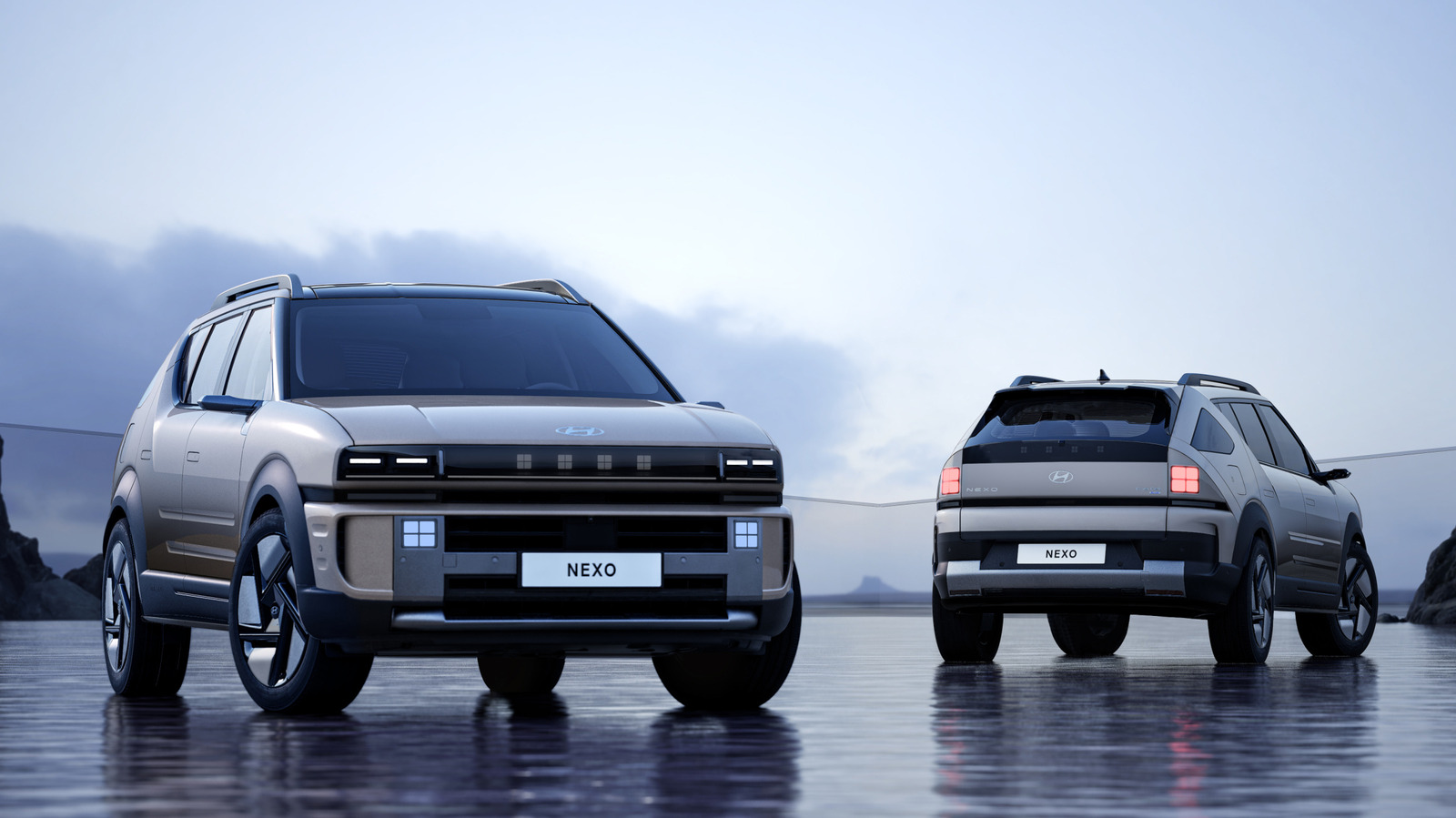After previewing it with the Initium concept at last year’s Los Angeles Auto Show, Hyundai has revealed the second generation of the Nexo hydrogen fuel-cell crossover, and it looks awesome. It’s nearly identical to that concept, in fact, with a boxy design that looks totally unlike any other Hyundai while still obviously looking like a Hyundai. The second-gen Nexo also has a luxe interior and a new, more efficient powertrain. Too bad hydrogen cars still just aren’t gonna happen, despite Hyundai calling the new Nexo “a significant milestone in hydrogen mobility.”
The first-gen Nexo was handsome and interesting enough but didn’t really stand out among a sea of other softly shaped crossovers. This new one, though, is rad as hell. Hyundai’s new design language is called Art of Steel, which it says “reflects the inherent strength and natural formability of the material.” The new Nexo is boxy and bold, with a Pontiac Aztek–like C- and D-pillar setup that actually works, angular creases and cutlines, prominent cladding and H-shaped bumper elements. What Hyundai calls “HTWO” lights (the brand’s “Hydrogen for Humanity” message), a large square made up of four small squares of light, are used as the front foglights and taillights. It all just looks rad as hell.
Padded for your pleasure
On the inside the second-gen Nexo looks more similar to other new Hyundais like the Palisade, but it still has some unique design elements. Though its wheelbase is the same, the new model is longer, wider and taller than the outgoing Nexo, and it has more passenger and cargo space as a result. Hyundai says the cargo area can fit four golf bags, and there’s some sort of customizable platform for accessories. The rear doors open wider than before, too.
The two-tier dashboard has an upper section that looks padded like a space suit, with the door panels ribbed to match. There’s a curved dual-screen display and a row of climate controls in the dash, and the center console affixed to the floor has storage cubbies and cupholders. Then you’ve got an “island-type” armrest with charging ports and pads, some hard controls and the fingerprint sensors. The Nexo will be available with Hyundai’s Premium Relaxation Seats that recline far back and have extendable legrests, as well as ventilated seats, a Bang & Olufsen sound system, ambient lighting, a “vision roof” (no idea what that is yet), new active-safety features, a built-in front and rear dash cam and other tech items.
More everything
Powering the Nexo is a 2.6-kWh battery pack with an 80-kW output (up by 1 kWh and 40 kW), a trio of 6.7-kg hydrogen tanks (up from 6.3 kg), and an electric motor that makes 201 horsepower and 258 pound-feet of torque (up by 40 hp and down by 33 lb-ft). The hydrogen fuel-cell stack now delivers a gross power of 148 hp, up by 16%, and total output from the whole powertrain system is now 258 hp, an increase of 77 hp. Hyundai says the new Nexo will hit 62 mph in 7.8 seconds, an improvement of a second and a half, and it will have a range of more than 435 miles. A route planner in the infotainment system aims to make long trips and fill-ups easier to plan.
The fuel-cell stack has improved durability and low-temperature operation, with a new “Wake Up” anti-freezing function that should make the Nexo easy to start year-round. Hyundai implemented all sorts of aerodynamic enhancements to increase efficiency and reduce noise, plus the Nexo wears special tires and has an active noise cancelation system. The regenerative braking system has an adaptive mode that takes into account navigation data, speed cameras, speed humps and the cars around you.
Like fetch, hydrogen isn’t gonna happen
Hyundai says the new Nexo is “coming to global markets later this year” as part of the company’s push to be “a pioneer in hydrogen mobility.” That will ostensibly include the U.S., where the first-gen Nexo has been sold since 2018. But as cool as I think the new Nexo is, and as much as I would love it if hydrogen tech suddenly became widespread, I just don’t think it’s going to happen — and especially not in the U.S. with Trump in the White House.
Global hydrogen car sales dropped by 22% in 2024 with only 12,866 new fuel-cell vehicles registered worldwide. To put that into perspective, Hyundai sold 44,400 electric Ioniq 5s just in the U.S. last year. Of those 12,866 hydrogen cars sold globally last year, 7,113 went to China and 3,688 went to South Korea, the latter being a 20.4% drop. In its seven-year lifespan Hyundai has sold barely 40,000 Nexos, fewer than 2,000 of which went to American consumers. The number of hydrogen stations in the U.S. is dwindling too, down to just 54 last year, the vast majority of which are in California. Though Hyundai says it’s committed to expanding hydrogen infrastructure, and I’m sure that may be possible in Asia and other parts of the world (if only for trucking), I can’t help but think the new Nexo would be a much better product if it were just one of Hyundai’s excellent EVs.






